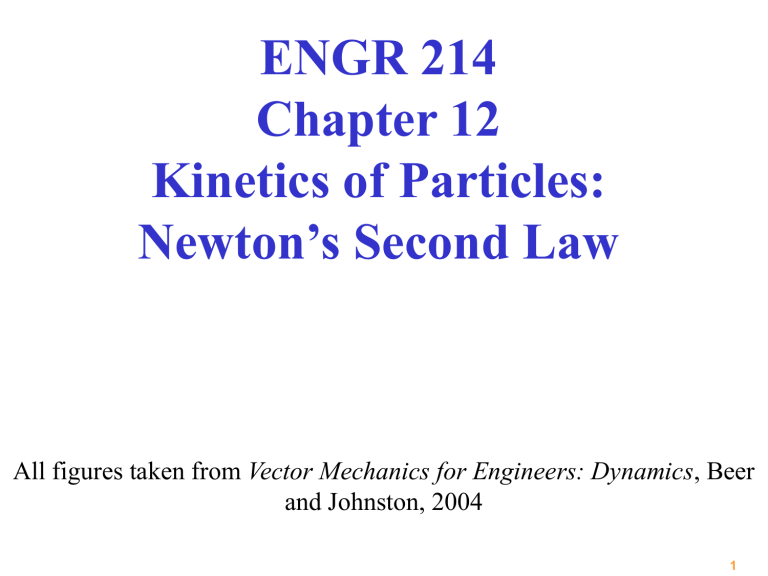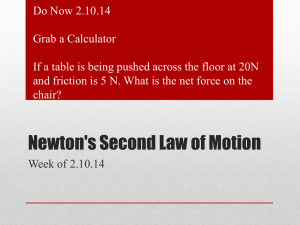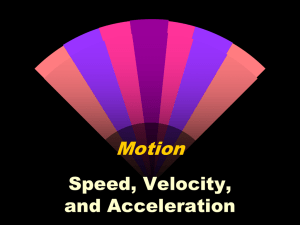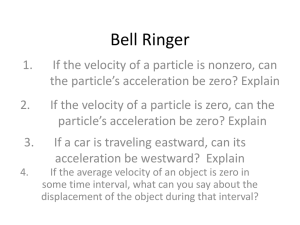Chapter 12

ENGR 214
Chapter 12
Kinetics of Particles:
Newton’s Second Law
All figures taken from Vector Mechanics for Engineers: Dynamics , Beer and Johnston, 2004
1
Newton’s Second Law of Motion
• If the resultant force acting on a particle is not zero, the particle will have an acceleration proportional to the magnitude of resultant and in the direction of the resultant.
F
ma
• If particle is subjected to several forces:
F
ma
• We must use a Newtonian frame of reference, i.e., one that is not accelerating or rotating.
• If no force acts on particle, particle will not accelerate, i.e., it will remain stationary or continue on a straight line at constant velocity.
2
Linear Momentum of a Particle
F
ma
m dv dt
d
d dt dt
If
L
mv Linear momentum
Sum of forces = rate of change of linear momentum
F
0 linear momentum is constant
F
L
Principle of conservation of linear momentum
3
Equations of Motion
• Newton’s second law
F
m a
• Convenient to resolve into components:
F x i
F y j
F z k
a x i
a y j
a z k
F x
F x
ma x m x
F y
F y
ma y m y
F z
F z
ma z m z
• For tangential and normal components:
F t
ma t
F n
ma n
F t
m dv dt
F n
m v
2
4
Dynamic Equilibrium
• Alternate expression of Newton’s law:
ma
F
ma
inertia vector
0
• If we include inertia vector, the system of forces acting on particle is equivalent to zero. The particle is said to be in dynamic equilibrium .
• Inertia vectors are often called inertia forces as they measure the resistance that particles offer to changes in motion.
5
Sample Problem 12.2
SOLUTION:
• Draw a free body diagram
• Apply Newton’s law. Resolve into rectangular components
An 80-kg block rests on a horizontal plane. Find the magnitude of the force P required to give the block an acceleration of 2.5 m/s 2 to the right. The coefficient of kinetic friction between the block and plane is m k
= 0.25.
6
Sample Problem 12.2
Pcos30
Psin30
W
mg
80 9.81 785 N
F
m k
N
0.25
N
F x
ma :
P cos30
0.25
N
200
F y
0 :
N
P sin30
785
0
Solve for P and N
N
P sin 30
785
P cos30
0.25
P sin 30
785
200
P
534.7
N
1052.4
N
N
7
Sample Problem 12.3
The two blocks shown start from rest.
The horizontal plane and the pulley are frictionless, and the pulley is assumed to be of negligible mass.
Determine the acceleration of each block and the tension in the cord.
8
Sample Problem 12.3
y
O x
• Kinematic relationship: If A moves x
A to the right, B moves down 0.5 x
A x
B
1
2 x
A a
B
1
2 a
A
Draw free body diagrams & apply Newton’s law:
F x
m a
A A
F y
m a
B B
T
1
a
A m g
B
T
2
m a
B B
300 9.81
T
2
300
a
B
T
2
a
B
F y
m a
C C
T
2
2 T
1
0 a
B
2 T
1
0 a
B
200 a
A
0 a
B
4.2
/ 2 a
B
a
B
0 a
A
8.4
/
2 T
1
840 N T
2
1680 N
9
Sample Problem 12.4
Block
Wedge
The 12-lb block B starts from rest and slides on the 30-lb wedge A , which is supported by a horizontal surface.
Neglecting friction, determine (a) the acceleration of the wedge, and (b) the acceleration of the block relative to the wedge.
10
a
Draw free body diagrams for block & wedge
N
1
N
1
N
1 sin q
N
1 cos q
W
B sin q a
Bn
Bt
W
B
W
B cos q
W
B sin q
12 0.5
12
32.2
m a
B Bt a
Bt
a
Bt
16.1
/
2
N
1 sin q m a
A A a
A
0.5
N
1
30
32.2
a
A
N
1
W
B cos q m a
B Bn
N
1 cos q
W
A
N
2
But a
Bn
a
A
N
1
W
B cos q sin q
Same normal acceleration (to maintain contact)
m a
B A sin q
N
1
10.39
32.2
a
A a
A
5.08
/ 2 a
Bn
2.54
/
2
11
N
1 a
Bn
W
B sin q a
Bt
W
B
W
B cos q
N
1
N
1 sin q
N
1 cos q a
Bx
a
Bt cos q a
Bn sin q
12.67
/
2 a
By
a
Bt sin q a
Bn cos q
10.25
/
2 a
12.67
i
10.25
j
5.08
i
17.75
i
10.25
j a a
A
a
B
a
A
30 °
20.5
12
Sample Problem 12.5
The bob of a 2-m pendulum describes an arc of a circle in a vertical plane. If the tension in the cord is 2.5 times the weight of the bob for the position shown, find the velocity and acceleration of the bob in that position.
13
Sample Problem 12.5
Resolve into tangential and normal components:
F t
ma t
: mg a t
sin g
30
sin
30
ma t a t
4 .
9 m s
2
F n
ma n
: 2 .
5 mg a n
g
mg
2 .
5
cos cos
30
30
a n ma n
16 .
03 m s
2 mgsin30 mgcos30
• Solve for velocity in terms of normal acceleration.
a n
v
2
v
a n
16 .
03 m v
s
2
5 .
66 m s
14
Sample Problem 12.6
SOLUTION:
• The car travels in a horizontal circular path with a normal component of acceleration directed toward the center of the path.The forces acting on the car are its weight and a normal reaction from the road surface.
• Resolve the equation of motion for the car into vertical and normal components.
Determine the rated speed of a highway curve of radius
= 400 ft banked through an angle q
= 18 o . The rated speed of a banked highway curve is the speed at which a car should travel if no lateral friction force is to be exerted at its wheels.
• Solve for the vehicle speed.
15
Sample Problem 12.6
SOLUTION:
• The car travels in a horizontal circular path with a normal component of acceleration directed toward the center of the path.The forces acting on the car are its weight and a normal reaction from the road surface.
• Resolve the equation of motion for the car into vertical and normal components.
F y
0 : R cos q
W
0
R
W cos q
F n
ma n
: R sin q
W g a n
W cos q sin q
W g v
2
• Solve for the vehicle speed.
v
2
g
tan
32 .
2 ft q s
2
400 ft
tan 18
v
64 .
7 ft s
44 .
1 mi h
16
Angular Momentum
From before, linear momentum: L
mv
Now angular momentum is defined as the moment of momentum
H
O
mv
H is a vector perpendicular to the plane
O containing r and mv
Resolving into radial & transverse components:
H
O
mv r
mr
2 q
Derivative of angular momentum with respect to time:
H
O
mv
mv
mv
ma
F
M
O
Sum of moments about O = rate of change of angular momentum
17
Equations of Motion in Radial & Transverse Components
F r
F q
ma r
ma q
m m
r
r q r
q
2
2
r q
18
Central Force
When force acting on particle is directed toward or away from a fixed point O , the particle is said to be moving under a central force.
O = center of force
Since line of action of the central force passes through O :
M
O
H
O
0 r
mv
H
O
constant
19
Sample Problem 12.7
A block B of mass m can slide freely on a frictionless arm OA which rotates in a horizontal plane at a constant rate q
0
.
Knowing that B is released at a distance r
0 from O, express as a function of r a) the component v r along OA , and of the velocity of B b) the magnitude of the horizontal force exerted on B by the arm OA .
SOLUTION:
• Write the radial and transverse equations of motion for the block.
• Integrate the radial equation to find an expression for the radial velocity.
• Substitute known information into the transverse equation to find an expression for the force on the block.
20
Sample Problem 12.7
r
r q
2
Write radial and transverse
equations of motion:
F r
m a r
F q
m a q
0
r q
2
F
q
2 r q
r v r
dv
But v r
r r q
2
v r dv r dr dt r v r
0
r q
2 v dv r dr r r o r o
dv r dr v r
2 dr dt r q
2 dr
v dv r r
q
0
2
v r r
2 dv r
dr r
0
2
v r
q
0
r
2 r
0
2
1 2
F
2 m q
0
2
r
2 r
0
2
1 2
21







